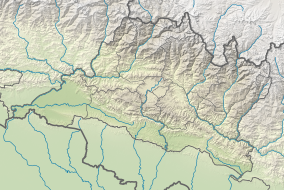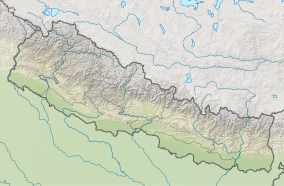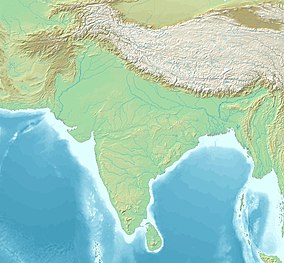Chitwan National Park
| Chitwan National Park | |
|---|---|
| Nepali: चितवन राष्ट्रिय निकुञ्ज | |
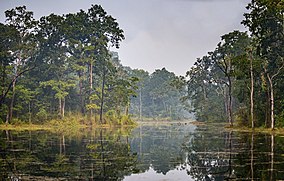 | |
| Location | Central Terai of Nepal |
| Nearest city | Bharatpur |
| Coordinates | 27°30′0″N 84°20′0″E / 27.50000°N 84.33333°E |
| Area | 952.63 km2 (367.81 sq mi) |
| Established | 1973 |
| Governing body | Department of National Parks and Wildlife Conservation |
 | |
South Asia | |
Chitwan National Park is the first national park of Nepal. It was established in 1973 as the Royal Chitwan National Park and was granted the status of a World Heritage Site in 1984.[1] It covers an area of 952.63 km2 (367.81 sq mi) in the subtropical Inner Terai lowlands of south-central Nepal in Nawalpur, Chitwan, Makwanpur and Parsa Districts. It ranges in elevation from about 100 m (330 ft) in the river valleys to 815 m (2,674 ft) in the Sivalik Hills.[2]
In the north and west of the protected area the Narayani-Rapti river system forms a natural boundary to human settlements. Adjacent to the east of Chitwan National Park is Parsa National Park, contiguous in the south is the Indian Tiger Reserve Valmiki National Park. The coherent protected area of 2,075 km2 (801 sq mi) represents the Tiger Conservation Unit (TCU) Chitwan-Parsa-Valmiki, which covers a 3,549 km2 (1,370 sq mi) huge block of alluvial grasslands and subtropical moist deciduous forests.[3]
History
Since the end of the 19th century Chitwan – Heart of the Jungle – used to be a favorite hunting ground for Nepal's ruling class during the cool winter seasons. Until the 1950s, the journey from
In 1950, Chitwan's forest and grasslands extended over more than 2,600 km2 (1,000 sq mi) and were home to about 800 rhinos. When poor farmers from the mid-hills moved to the Chitwan Valley in search of arable land, the area was subsequently opened for settlement, and poaching of wildlife became rampant. In 1957, the country's first conservation law inured to the protection of rhinos and their habitat. In 1959, Edward Pritchard Gee undertook a survey of the area, recommending creation of a protected area north of the Rapti River and of a wildlife sanctuary south of the river for a trial period of ten years.[5] After his subsequent survey of Chitwan in 1963, this time for both the Fauna Preservation Society and the International Union for Conservation of Nature, he recommended extension of the sanctuary to the south.[6]
By the end of the 1960s, 70% of Chitwan's jungles had been cleared, malaria eradicated using DDT, thousands of people had settled there, and only 95 rhinos remained. The dramatic decline of the rhino population and the extent of poaching prompted the government to institute the Gaida Gasti – a rhino reconnaissance patrol of 130 armed men and a network of guard posts all over Chitwan. To prevent the extinction of rhinos, the Chitwan National Park was gazetted in December 1970, with borders delineated the following year and established in 1973, initially encompassing an area of 544 km2 (210 sq mi).[7]
When the first protected areas were established in Chitwan, Tharu communities were forced to relocate from their traditional lands. They were denied any right to own land and thus forced into a situation of landlessness and poverty. When the national park was designated, Nepalese soldiers destroyed the villages located inside the boundary of the park, burning down houses and trampling fields using elephants. The Tharu people were forced to leave at gunpoint.[8]
In 1977, the park was enlarged to its present area of 952.63 km2 (367.81 sq mi). In 1997, a bufferzone of 766.1 km2 (295.8 sq mi) was added to the north and west of the Narayani-Rapti river system, and between the south-eastern boundary of the park and the international border to India.[2]
The park's headquarters is in Kasara. Close by the gharial and turtle conservation breeding centres have been established. In 2008, a vulture breeding centre was inaugurated aiming at holding up to 25 pairs of each of the two
Climate
Chitwan has a humid subtropical monsoon influenced climate (Cwa) with high humidity all through the year.[4] The area is located in the central climatic zone of the Himalayas, where monsoon starts in mid June and eases off in late September. During these 14–15 weeks most of the 2,500 mm (98 in) annual precipitation falls. After mid-October, the monsoon clouds retreat, humidity drops off, and the top daily temperature gradually subsides from around 36 °C (97 °F) to 18 °C (64 °F). Nights cool down to 5 °C (41 °F) until late December, when it usually rains softly for a few days. Then temperatures start rising gradually.[citation needed]
Vegetation

The typical vegetation of the Inner Terai is
Seasonal
Fauna

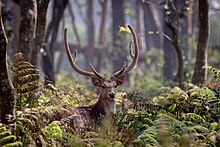
The wide range of vegetation types in the Chitwan National Park is haunt of more than 700 species of wildlife and a not yet fully surveyed number of
Mammals
Chitwan National Park is home to 68
Indian leopards are most prevalent on the peripheries of the park. They co-exist with tigers, but being socially subordinate are not common in prime tiger habitat.[15] In 1988, a clouded leopard (Neofelis nebulosa) was captured and radio-collared outside the protected area. It was released into the park, but did not stay there.[16]
Chitwan is considered to have the highest population density of sloth bears with an estimated 200 to 250 individuals. Smooth-coated otters inhabit the numerous creeks and rivulets. Bengal foxes, spotted linsangs and honey badgers roam the jungle for prey. Striped hyenas prevail on the southern slopes of the Churia Hills.[17] During a camera trapping survey in 2011, dholes were recorded in the southern and western parts of the park, as well as Indian jackals, fishing cats, jungle cats, leopard cats, crab-eating mongooses, yellow-throated martens, large, small Indian and Asian palm civets.[18]
Birds
Every year dedicated bird watchers and conservationists survey bird species occurring all over the country. In 2006 they recorded 543 species in the Chitwan National Park, much more than in any other protected area in Nepal and about two-thirds of Nepal's globally
Especially the park's alluvial grasslands are important habitats for the critically endangered Bengal florican, the vulnerable lesser adjutant, grey-crowned prinia, swamp francolin and several species of grass warblers. In 2005 more than 200 slender-billed babblers were sighted in three different grassland types.[21] The near threatened Oriental darter is a resident breeder around the many lakes, where egrets, bitterns, storks and kingfishers also abound. The park is one of the few known breeding sites of the globally threatened
Apart from the resident birds about 160 migrating and vagrant species arrive in Chitwan in autumn from northern latitudes to spend the winter here, among them the
As soon as the winter visitors have left in spring, the summer visitors arrive from southern latitudes. The calls of cuckoos herald the start of spring. The colourful pitta and several sunbird species are common breeding visitors during monsoon. Among the many flycatcher species the Indian paradise flycatcher with his long undulating tail in flight is a spectacular sight.[citation needed]
Literature
- Bird Conservation Nepal (2006). Birds of Chitwan. Checklist of 543 reported species. Published in cooperation with Department of National Parks and Wildlife Conservation and Participatory Conservation Programme II, Kathmandu.
- Gurung, K. K., Singh R. (1996). Field Guide to the Mammals of the Indian Subcontinent. Academic Press, San Diego, ISBN 0-12-309350-3
Media coverage
The park's unique rhino herd was featured on The Jeff Corwin Experience in season 2, episode 11.
See also
References
- ^ Centre, UNESCO World Heritage. "Chitwan National Park". UNESCO World Heritage Centre. Retrieved 2023-05-15.
- ^ ISBN 978-92-9115-033-5.
- ISBN 0-521-64835-1. Archived from the originalon 10 March 2012. Retrieved 23 October 2011.
- ^ a b Gurung, K. K. (1983). Heart of the Jungle: the Wildlife of Chitwan, Nepal. André Deutsch, London.
- .
- .
- ^ a b Adhikari, T. R. (2002). The curse of success. Habitat Himalaya - A Resources Himalaya Factfile, Volume IX, Number 3.
- ^ McLean, J. (1999). "Conservation and the impact of relocation on the Tharus of Chitwan, Nepal". Himalayan Research Bulletin. XIX (2): 38–44.
- JSTOR 1941155.
- ^ Shrestha, B. K., Dangol, D. R. (2006). Change in Grassland Vegetation in the Northern Part of Royal Chitwan National Park, Nepal. Scientific World, Vol. 4, No. 4: 78–83.
- ^ Priol, P. (2003). Gharial field study report (Report). Kathmandu, Nepal: A report submitted to Department of National Parks and Wildlife Conservation.
- ^ Chitwan National Park Office (2015). "Biodiversity – Chitwan National Park". Government of Nepal Department of National Parks and Wildlife Conservation. Archived from the original on 2021-08-12. Retrieved 2018-01-21.
- .
- PMID 22949642.
- ^ McDougal, C. (1988). "Leopard and Tiger Interactions at Royal Chitwan National Park, Nepal". Journal of the Bombay Natural History Society. 85: 609–610.
- .
- ^ a b Jnawali, S. R.; Baral, H. S.; Lee, S.; Acharya, K. P.; Upadhyay, G. P.; Pandey, M.; Shrestha, R.; Joshi, D.; Lamichhane, B. R.; Griffiths, J.; Khatiwada, A. P.; Subedi, N. & Amin, R. (2011). The Status of Nepal’s Mammals: The National Red List Series (PDF). Kathmandu, Nepal: Department of National Parks and Wildlife Conservation.
- ^ Thapa, K.; Kelly, M. J.; Karki, J. B.; Subedi, N. (2013). "First camera trap record of pack hunting dholes in Chitwan National Park, Nepal". Canid Biology & Conservation. 16 (2): 4–7.
- ^ Chitwan National Park Office (2015). "Rhino population". Government of Nepal Department of National Parks and Wildlife Conservation. Retrieved 31 January 2016.
- ^ Giri, T.; Choudhary, H. (2008). "Additional Sightings". Danphe. 17 (2): 6.
- ^ Baral, H. S.; Chaudhary, D. B. (2006). "Status and Distribution of Slender-billed babbler Turdoides longirostris in Chitwan National Park, central Nepal". Danphe. 15 (4): 1–6.
External links
- Department of National Parks and Wildlife Conservation, Nepal : Chitwan National Park Archived 2019-07-04 at the Wayback Machine
- Chitwan National Park
- UNESCO World Heritage Site Link
- BirdLife International. "Important Bird Areas factsheet: Chitwan National Park".
- Vulture Breeding Centre in Chitwan National Park

